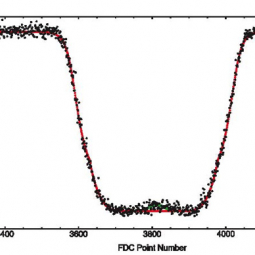On June 23, 2011 SOFIA observed an occultation by dwarf planet Pluto of a comparably bright (V ~ +14) star using two instruments simultaneously: HIPO (High Speed Photometer for Occultations; P.I. = Ted Dunham, Lowell Observatory) and FDC (Fast Diagnostic Camera; P.I. = Jürgen Wolf, DSI). The results were published in Person et al. 2013, Astrophysical Journal 146, 83.
SOFIA’s Pluto occultation light curves show a wide and shallow central flash that would not have been observable without SOFIA’s mobility and capability for last minute repositioning at the center of the shadow track. The light curves indicate that the low-altitude structure of Pluto’s atmospheres is different from the high-altitude structure. Based on comparison with previous occultation observations, Pluto’s upper atmosphere appears stable but the lower atmosphere evolves on time scales of years. A thermal gradient model matches the flux increase in the central portion of the light curve reasonably well. The light curve also indicates a sharply bounded troposphere or haze layer has returned after slowly fading away over the decades since the previous airborne observations. Detailed analyses of the light curve indicate that the atmosphere has elliptical density contours, possibly revealing high-speed winds and global circulation.
SOFIA is a joint project of NASA and the German Aerospace Center (DLR). The aircraft is based at the NASA Armstrong Science and Aircraft Integration Facility in Palmdale, Calif. NASA Armstrong Flight Research Center manages the program. NASA Ames Research Center at Moffett Field, Calif., manages the SOFIA science and mission operations in cooperation with the Universities Space Research Association (USRA) headquartered in Columbia, Md., and the German SOFIA Institute (DSI) at the University of Stuttgart.


